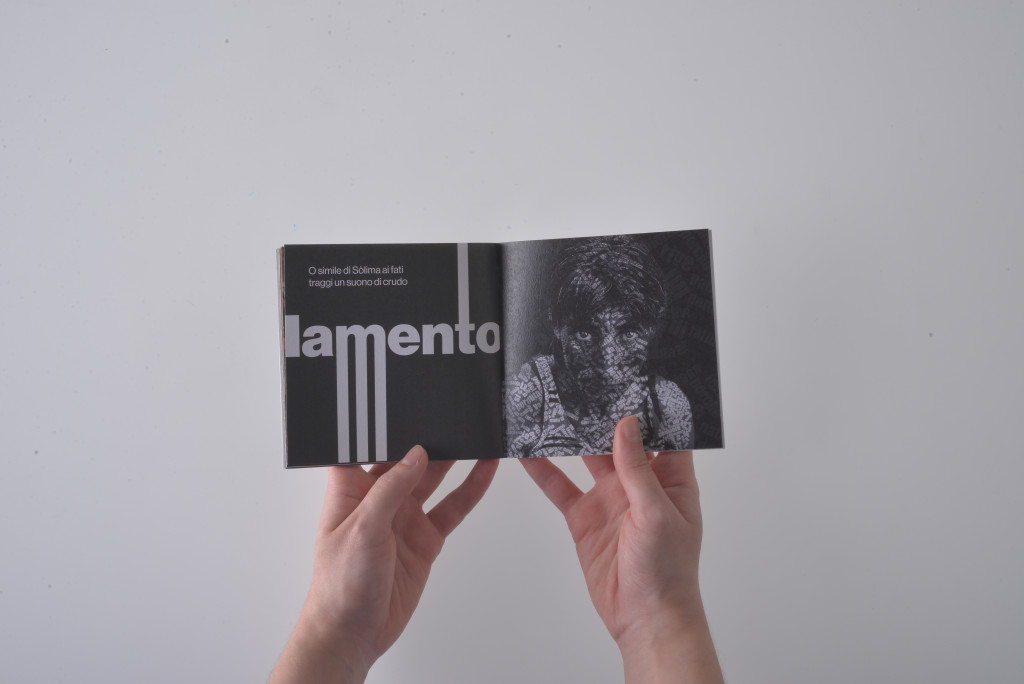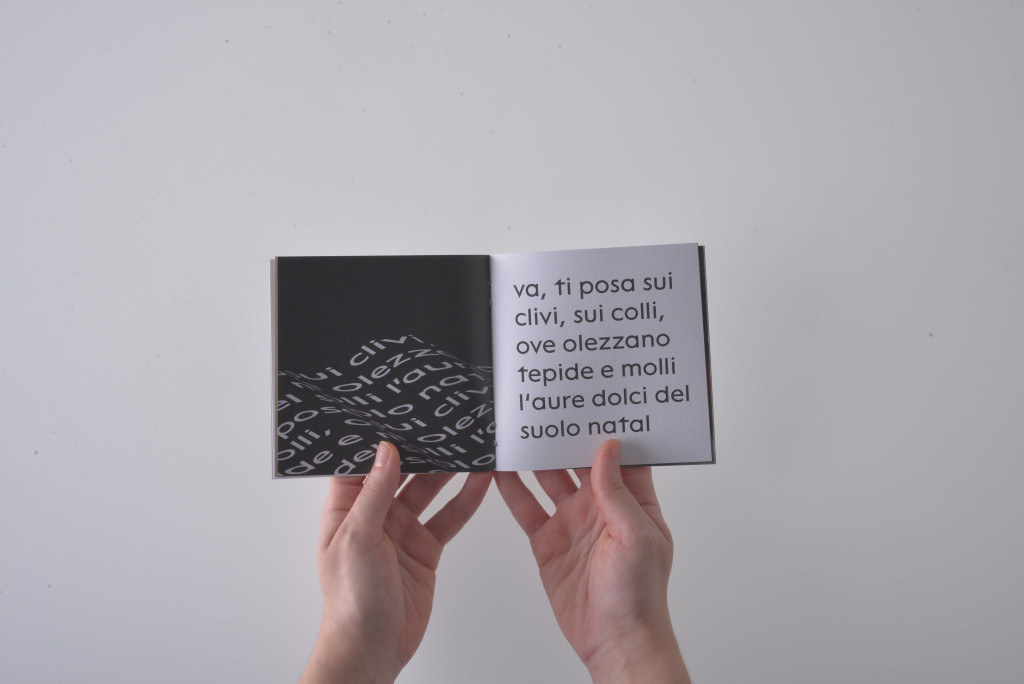Va, pensiero
BA Visual Communication Project
2022
semester

EN
I designed 4 books giving different analyses to the Va Pensiero, the most famous aria of the Nabucco, third opera composed by Giuseppe Verdi between 1841-1842.
The text and theme are the same, but the typography, graphics and images give different interpretations and facets also for nowadays life. The original Va pensiero is sung by the chorus of the Jewish people, threatened by the prospect of a life of slavery. The meaning of the verses revolves around the non-belonging of the Jewish people to their land and the relationship between man and his desire for freedom. It is a hymn of freedom. Always around the feeling of freedom, the second book highlights migration, war and limitations. Migration especially for women is mostly unrelated to career advancement and skills acquisition. Women also often serve as the primary caregivers of children and elderly family members, increasing their need for support. The third book regrets the freedom to live everyday life due to the covid-19 pandemic and the fourth one considers the obsolete concept of home today. Home is where we feel comfortable, it can be a hut, a bungalow, a villa. If it gives you happiness and freedom, then it’s home. I mainly chose clear and legible fonts, and I played a lot with typography, graphics and images trying to convey emotions and moods. Even the tear on the cover is not random but has a meaning of anger, rebellion, escape and desperate desire for freedom. The binding wants to be simple and rough, also considering the 24 pages per book it was the optimal solution. There are no equal pages in any of the 4 books except for the back covers on which there is the Va pensiero score. To keep the 4 books together, I built a box using a paper with a particular texture.
IT
Ho progettato 4 libri dando diverse analisi al Va Pensiero, l’aria più famosa del Nabucco, terza opera lirica di Giuseppe Verdi composta tra il 1841 e il 1842.
Il testo e il tema sono gli stessi, ma la tipografia, la grafica e le immagini danno interpretazioni e sfaccettature diverse. Il Va pensiero originale è intonato dal coro del popolo ebraico, minacciato dalla prospettiva di una vita di schiavitù. Il significato dei versi ruota intorno alla non-appartenenza del popolo ebraico alla propria terra e al rapporto tra l’uomo e il suo desiderio di libertà. È un inno di libertà. Sempre attorno al sentimento di libertà, il secondo libro mette in luce la migrazione, la guerra e le limitazioni. La migrazione, in particolar modo per le donne, è per lo più estranea all’avanzamento di carriera e all’acquisizione di competenze. Infatti spesso le donne sono anche le principali assistenti di bambini e familiari anziani, ciò aumenta il loro bisogno di sostegno. Il terzo libro rimpiange la libertà di vivere il quotidiano a causa della pandemia da covid-19 e il quarto considera l’obsoleto concetto di casa oggi. Casa è dove siamo a nostro agio, può essere una capanna, un bungalow, una villa. Se ti dà felicità e libertà allora è casa.
Ho scelto principalmente dei font chiari e leggibili. Ho giocato molto con la tipografia e la grafica cercando di far trasparire emozioni e stati d’animo. Anche lo strappo sulla copertina non è casuale ma ha un significato di rabbia, di ribellione, di fuga e di disperato desiderio di libertà. La rilegatura vuole essere semplice e grezza, considerate anche le 24 pagine per libro era la soluzione ottimale. Non ci sono pagine uguali in nessuno dei 4 libri con eccezione del retro delle copertine sui quali c’è lo spartito del Va pensiero. Ho infine costruito una scatola con una carta dalla trama particolare per custodire i 4 libri.
DE
Ich habe 4 Bücher entworfen, die unterschiedliche Analysen zu Va Pensiero, der berühmtesten Arie des Nabucco, der dritten Oper, die von Giuseppe Verdi zwischen 1841-1842 komponiert wurde, enthalten. Der Text und das Thema sind gleich, aber die Typografie, Grafiken und Bilder geben unterschiedliche Interpretationen und Facetten auch für das heutige Leben. Das Original Va pensiero wird vom Chor des jüdischen Volkes gesungen, das von der Aussicht auf ein Leben in Sklaverei bedroht ist. Die Bedeutung der Verse dreht sich um die Nichtzugehörigkeit des jüdischen Volkes zu seinem Land und die Beziehung zwischen dem Menschen und seinem Wunsch nach Freiheit. Es ist eine Hymne der Freiheit. Immer um das Gefühl von Freiheit dreht sich das zweite Buch um Migration, Krieg und Einschränkungen. Migration, insbesondere für Frauen, steht meist in keinem Zusammenhang mit beruflichem Aufstieg und Qualifikationserwerb. Frauen dienen auch oft als primäre Bezugspersonen von Kindern und älteren Familienmitgliedern, was deren Bedarf an Unterstützung erhöht. Das dritte Buch bedauert die Freiheit, den Alltag aufgrund der Covid-19-Pandemie zu leben, und das vierte befasst sich mit dem veralteten Konzept von Heimat heute. Zuhause ist da, wo wir uns wohlfühlen, das kann eine Hütte sein, ein Bungalow, eine Villa. Wenn es dir Glück und Freiheit gibt, dann ist es dein Zuhause. Ich habe hauptsächlich klare und lesbare Schriftarten gewählt und viel mit Typografie, Grafiken und Bildern gespielt, um Emotionen und Stimmungen zu vermitteln. Auch der Riss auf dem Cover ist nicht zufällig, sondern hat eine Bedeutung für Wut, Rebellion, Flucht und verzweifelten Wunsch nach Freiheit. Die Bindung will einfach und grob sein, auch in Anbetracht der 24 Seiten pro Buch war es die optimale Lösung. In keinem der 4 Bücher gibt es gleiche Seiten, mit Ausnahme der Rückseiten, auf denen sich die Partitur von Va pensiero befindet. Um die 4 Bücher zusammenzuhalten, habe ich eine Schachtel aus Papier mit einer bestimmten Textur gebaut.














